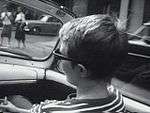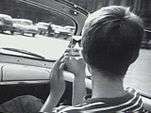Jump cut
A jump cut is a cut in film editing in which two sequential shots of the same subject are taken from camera positions that vary only slightly if at all. This type of edit gives the effect of jumping forwards in time. It is a manipulation of temporal space using the duration of a single shot, and fracturing the duration to move the audience ahead. This kind of cut abruptly communicates the passing of time as opposed to the more seamless dissolve heavily used in films predating Jean-Luc Godard's Breathless, when jump cuts were first used extensively. For this reason, jump cuts, while not seen as inherently bad, are considered a violation of classical continuity editing, which aims to give the appearance of continuous time and space in the story-world by de-emphasizing editing. Jump cuts, in contrast, draw attention to the constructed nature of the film.[1]
Continuity editing uses a guideline called the "30 degree rule" to avoid jump cuts. The 30 degree rule advises that for consecutive shots to appear "seamless," the camera position must vary at least 30 degrees from its previous position. Some schools would call for a change in framing as well (e.g., from a medium shot to a close up). Generally, if the camera position changes less than 30 degrees, the difference between the two shots will not be substantial enough, and the viewer will experience the edit as a jump in the position of the subject that is jarring, and draws attention to itself. Although jump cuts can be created through the editing together of two shots filmed non-continuously (spatial jump cuts), they can also be created by removing a middle section of one continuously filmed shot (temporal jump cuts).
Jump cuts can add a sense of speed to the sequence of events.


History
Georges Méliès is known as the father of the jump cut as a result of having discovered it accidentally, and then using it to simulate magical tricks; however, he tried to make the cut appear seamless to complement his illusions. Dziga Vertof's avant-garde Russian film Man With a Movie Camera (1929) is almost entirely composed of jump cuts. Contemporary use of the jump cut stems from its appearance in the work of Jean-Luc Godard (at the suggestion of Jean-Pierre Melville) and other filmmakers of the French New Wave of the late 1950s and 1960s. In Godard's ground-breaking Breathless (1960), for example, he cut together shots of Jean Seberg riding in a convertible (see image) in such a way that the discontinuity between shots is emphasized and its jarring effect deliberate. In the screen shots to the right, the first image comes from the very end of one shot and the second is the very beginning of the next shot — thus emphasizing the gap in action between the two (when Seberg picked up the mirror). Recently the jump cut has been used in films like Snatch, by Guy Ritchie, and Run Lola Run, by Tom Tykwer. It is frequently used in TV editing, in documentaries produced by Discovery Channel and National Geographic Channel (NatGeo), for example. It is noticeable in Universal Monsters films and music videos.
Notable examples
The jump cut has sometimes served a political use in film. It has been used as an alienating Brechtian technique (the Verfremdungseffekt) that makes the audience aware of the unreality of the film experience, in order to focus the audience's attention on the political message of a film rather than the drama or emotion of the narrative—as may be observed in some segments of Sergei Eisenstein's The Battleship Potemkin.
It was also used in Alexander Dovzhenko's Arsenal (Soviet Union, 1930), where a close-up shot of a character's face cuts closer and closer a total of nine times. Mark Cousins comments that this 'fragmentation captured his indecision... and confusion',[2] adding that 'Although the effect jars, the idea of visual conflict was central to Soviet montage cinema of that time'.
Jump cuts are sometimes used to show a nervous searching scene as is done in the 2009 science fiction film Moon in which the protagonist, Sam Bell, is looking for a secret room on a moon base, and District 9 in which the protagonist, Wikus, searches for illegal objects in the house of Christopher's friend.
In television, Rowan & Martin's Laugh-In editor Arthur Schneider won an Emmy Award in 1968 for his pioneering use of the jump cut. Jump cutting remained an uncommon TV technique until shows like Homicide: Life on the Street popularized it on the small screen in the 1990s.
The well-remembered music video for "Everybody Have Fun Tonight" has a jump cut for virtually every frame.
Other uses of the jump cuts include Vincent Gallo's short "Flying Christ" in which various shots of "christ" jumping are cut together as he is in mid jump, creating the illusion of flight, and in many vlogs online, as popularized by the show with zefrank.
British comedian Russell Kane has produced a series of comic, satirical videos, named "Kaneings", in response to current events. These make extensive use of jump cut-style editing.
Confusion with other transitions
Vernacular use of the term jump cut can be used to describe any abrupt or noticeable edit in a film. However, technically many such over-broad usages are incorrect. In particular, a cut between two different subjects is not a true jump cut, no matter how jarring.
A match cut (a.k.a. graphic match) may also be abrupt, but the viewer is meant to see the similarity between two scenes with disparate subjects rather than experience the discontinuity between the two shots. A well-known example is found at the end of the "Dawn of Man" sequence in the film 2001: A Space Odyssey. A primitive hominid discovers the use of a bone as a weapon and throws it into the air. When the bone reaches its highest point, the shot cuts to that of a similarly shaped space station in orbit above the earth. This edit has been described as a jump cut by those unfamiliar with film editing terminology (even on the box of the DVD release of the film), but it is properly termed as a graphic match or a match cut.
Jump cuts are also distinguishable from an impossible match on action (a.k.a. impossible continuous action), where the action of the subject seems continuous and fluid but the background suddenly changes in an impossible way. Several of the cuts, sometimes mislabeled jump cuts, in the "Patricia in the car" sequence from Godard's Breathless are actually examples of impossible match on action. Other infamous examples include Resnais' Last Year in Marienbad, and the "air mattress to Mrs. Robinson" cut in The Graduate.
See also
References
- ↑ Bordwell, David; Thompson, Kristin (2006). Film Art: An Introduction (8th Edition). New York: McGraw Hill. p. 254. ISBN 978-0-07-331027-5.
- ↑ Cousins, Mark (2004). The Story of Film (1st Edition). London: Pavilion. p. 270
External links
- "Jump cut", moviesaremade.com article on jump cuts as film storytelling techniques and showcasing an array of examples from various genres of movies.
- "Avoiding Audio Jump Cuts", AskTheCameraMan.net article explaining what jump cuts in audio are and how/why to avoid them